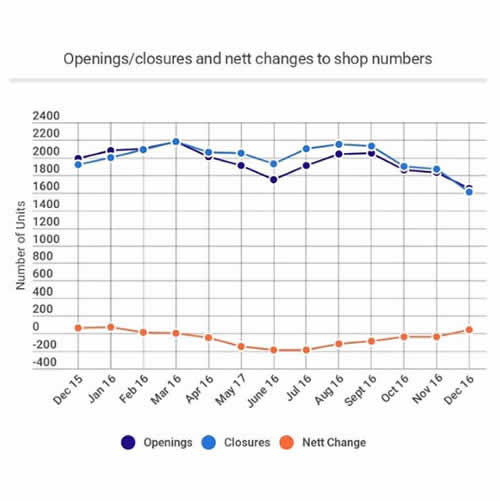Retail occupancy rose in 2016, with more stores opening than closing overall, new data has revealed.
The London Data Company Dynamic Location Intelligence Bulletin – December 2016 surveyed 2,700 towns and cities nationwide. It found there was a summer slump with openings and closures both falling. Both rallied in the autumn, followed by a mutual decline in the winter, with closures falling below openings. This boosted overall shop numbers as Christmas approached.
Seasonal operators and festive pop-up shops will have accounted for some of this late gain, it said.
The only decline was seen in the non-food sector, where the index showed weakening numbers throughout the year.
National chain stores continued to withdraw from UK high streets with numbers falling throughout the year. Across the sample of 650 towns, closed stores outnumbered new shops by nearly 1,000. However, this averaged out at a net loss of 1.5 stores in each town surveyed.
Independents continued to generate openings and closings at three times the rate of their national competitors. They ended the year with more shops in operation than the previous year. The net 12-month gain totalled just 207 after openings and closures each exceeded 17,000 across the whole period.
For the whole year, more than 21,000 shops opened for the first time in the sample towns, which was slightly higher than closures. This meant that roughly one-in-10 stores changed occupant.
Britain’s retail vacancy rate fell to its lowest rate in December 2016 at 12.2 per cent since its peak in 2010.
The vacancy rate among leisure outlets hit a new high of 8.2 per cent. A mixture of both retail and leisure vacancy rates fell back to its lowest level over the past four years, at 11.1 per cent. One-in-nine retail and leisure units currently stands empty.
LDC sales and marketing director Matthew Hopkinson said: “There is a great deal of life in the high street and our new bulletin brings to light just how lively our retail locations are. There is also a great deal of its opposite, retail death. More than one in ten shop units changed occupant last year. The fortunes of our high streets depend on which is the stronger trend, births or deaths. In the summer, closures were more numerous than openings, but in the autumn and winter growth took the lead.
“Paradoxically, numbers of shops grew as winter drew on and the vacancy rate finally began to fall again – despite the fact that overall levels of activity dropped as the year headed towards its end,” he added. “Our new report clearly demonstrates that it is the balance of openings and closures that delivers growth or decline – and that plays a key role in driving vacancy rates.
“The news at the end of the year was better than at the halfway stage even though the curves were heading downward. In a year that will see Brexit triggered, business rate hikes for some shops and rising input cost pressures, the balance between these two facts of commercial life, births and deaths, will determine outcomes on the high street. This will have much to do with how confident businesses feel in the face of uncertainty. We will track all of these indices as 2017 unfolds.”


